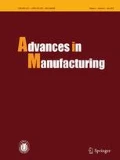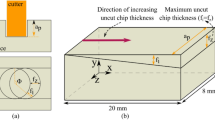Abstract
During the actual high-speed machining process, it is necessary to reduce the energy consumption and improve the machined surface quality. However, the appropriate prediction models and optimal cutting parameters are difficult to obtain in complex machining environments. Herein, a novel intelligent system is proposed for prediction and optimization. A novel adaptive neuro-fuzzy inference system (NANFIS) is proposed to predict the energy consumption and surface quality. In the NANFIS model, the membership functions of the inputs are expanded into: membership superior and membership inferior. The membership functions are varied based on the machining theory. The inputs of the NANFIS model are cutting parameters, and the outputs are the machining performances. For optimization, the optimal cutting parameters are obtained using the improved particle swarm optimization (IPSO) algorithm and NANFIS models. Additionally, the IPSO algorithm as a learning algorithm is used to train the NANFIS models. The proposed intelligent system is applied to the high-speed milling process of compacted graphite iron. The experimental results show that the predictions of energy consumption and surface roughness by adopting the NANFIS models are up to 91.2% and 93.4%, respectively. The NANFIS models can predict the energy consumption and surface roughness more accurately compared with other intelligent models. Based on the IPSO algorithm and NANFIS models, the optimal cutting parameters are obtained and validated to reduce both the cutting power and surface roughness and improve the milling efficiency. It is demonstrated that the proposed intelligent system is applicable to actual high-speed milling processes, thereby enabling sustainable and intelligent manufacturing.









Similar content being viewed by others
Abbreviations
- a p :
-
Depth of cut
- V :
-
Cutting speed
- f r :
-
Feed per tooth
- d :
-
Diameter of the cutting plate
- F t :
-
Tangential force
- P c :
-
Cutting power
- R 2 :
-
Coefficient of determination
- a r :
-
Radial depth of cut
- f c :
-
Cutting power model
- f s :
-
Surface roughness model
- NANFIS:
-
Novel adaptive neural fuzzy inference system
- SANFIS:
-
Standard adaptive neural fuzzy inference system
- IPSO:
-
Improved particle swarm optimization
- CANFIS:
-
Complex adaptive neural fuzzy inference system
- CGI:
-
Compacted graphite iron
- MRR:
-
Material removal rate
- RMSE:
-
Root mean square error
- ANFIS:
-
Adaptive neural fuzzy inference system
- f M :
-
Material removal rate model
- ANOVA:
-
Analysis of variance
- a d :
-
Axial depth of cut
References
Zhong N, Zhou YX, Zhu XF et al (2011) Microstructure and cutting performance of carbonitride coated tools in high speed machining of 40Cr steel. Surf Eng 27(4):306–310
Tlhabadira I, Daniyan IA, Machaka R et al (2019) Modelling and optimization of surface roughness during AISI P20 milling process using Taguchi method. Int J Adv Manuf Tech 102(9):3707–3718
Shi KN, Ren JX, Wang SB et al (2019) An improved cutting power-based model for evaluating total energy consumption in general end milling process. J Clean Prod 231:1330–1341
Zhu CM, Gu P, Wu YY et al (2019) Surface roughness prediction model of SiCp/Al composite in grinding. Int J Mech Sci 155:98–109
Liu N, Zhang YF, Lu WF (2015) A hybrid approach to energy consumption modelling based on cutting power: a milling case. J Clean Prod 104:264–272
He Y, Wang LX, Wang YL et al (2019) An analytical model for predicting specific cutting energy in whirling milling process. J Clean Prod 240:1–16
Kant G, Sangwan KS (2015) Predictive modeling for energy consumption in machining using artificial neural network. Proc CIRP 37:205–210
Pimenov DY, Bustillo A, Mikolajczyk T (2018) Artificial intelligence for automatic prediction of required surface roughness by monitoring wear on face mill teeth. J Intell Manuf 29(5):1045–1061
Bustillo A, Pimenov DY, Mia M et al (2020) Machine-learning for automatic prediction of flatness deviation considering the wear of the face mill teeth. J Intell Manuf. https://doi.org/10.1007/s10845-020-01645-3
Lau HCW, Cheng ENM, Lee CKM et al (2008) A fuzzy logic approach to forecast energy consumption change in a manufacturing system. Expert Syst Appl 34(3):1813–1824
Ullah I, Ahmad R, Kim D (2018) A prediction mechanism of energy consumption in residential buildings using hidden Markov model. Energies 11(2):358–359
Misaka T, Herwan J, Ryabov O et al (2020) Prediction of surface roughness in CNC turning by model-assisted response surface method. Precis Eng 62:196–203
Li LB, Wu MY, Liu XL et al (2017) The prediction of surface roughness of PCBN turning GH4169 based on adaptive genetic algorithm. Integr Ferroelectr 180(1):118–132
Rizal M, Ghani JA, Nuawi MZ et al (2013) Online tool wear prediction system in the turning process using an adaptive neuro-fuzzy inference system. Appl Soft Comput 13:1960–1968
Maher I, Eltaib MEH, Sarhan A et al (2014) Investigation of the effect of machining parameters on the surface quality of machined brass (60/40) in CNC end milling-ANFIS modeling. Int J Adv Manuf Tech 74(1):531–537
Sparham M, Sarhan AAD, Mardi NA et al (2017) ANFIS modeling to predict the friction forces in CNC guideways and servomotor currents in the feed drive system to be employed in lubrication control system. J Manuf Process 28:168–185
Sarkheyli A, Azlan MZ, Safian S (2015) Robust optimization of ANFIS based on a new modified GA. Neurocomputing 166:357–366
Adedeji PA, Stephen A, Nkosinathi M et al (2020) Wind turbine power output very short-term forecast: a comparative study of data clustering techniques in a PSO-ANFIS model. J Clean Prod 254:120–135
Hasanipanah M, Amnieh HB, Arab H et al (2018) Feasibility of PSO-ANFIS model to estimate rock fragmentation produced by mine blasting. Neural Comput Appl 30:1015–1024
Pimenov DY, Abbas AT, Gupta MK et al (2020) Investigations of surface quality and energy consumption associated with costs and material removal rate during face milling of AISI 1045 steel. Int J Adv Manuf Tech 107(7):3511–3525
Abbas AT, Pimenov DY, Erdakov IN et al (2019) Optimization of cutting conditions using artificial neural networks and the Edgeworth-Pareto method for CNC face-milling operations on high-strength grade-H steel. Int J Adv Manuf Tech 105(5):2151–2165
Krimpenis AA, Fountas NA (2016) Balancing multiple criteria in formulation of weighted, single-objective genetic algorithm optimization for CNC machining problems. Adv Manuf 4:178–188
Manivel D, Gandhinathan R (2016) Optimization of surface roughness and tool wear in hard turning of austempered ductile iron (grade 3) using Taguchi method. Measurement 93:108–116
Negrete C (2015) Optimization of cutting parameters using response surface method for minimizing energy consumption and maximizing cutting quality in turning of AISI 6061 T6 aluminum. J Clean Prod 91:109–117
Keshtiara M, Golabi S, Tarkesh ER (2019) Multi-objective optimization of stainless steel 304 tube laser forming process using GA. Eng Comput-Germany. https://doi.org/10.1007/s00366-019-00814-0
Babaei M, Mollayi M (2016) Multi-objective optimization of reinforced concrete frames using NSGA-II algorithm. Eng Struct Technol 8(4):157–164
Li L, Deng X, Zhao J et al (2018) Multi-objective optimization of tool path considering efficiency, energy-saving and carbon-emission for free-form surface milling. J Clean Prod 172:3311–3322
Ampellio E, Vassio L (2016) A hybrid swarm-based algorithm for single-objective optimization problems involving high-cost analyses. Swarm Intell-US 10(2):99–121
Saw LH, Ho LW, Yew MC et al (2018) Sensitivity analysis of drill wear and optimization using adaptive neuro fuzzy-genetic algorithm technique toward sustainable machining. J Clean Prod 172:3289–3298
Jang JSR (1993) ANFIS: adaptive-network-based fuzzy inference system. IEEE Trans Syst Man Cybern 23:665–685
Hosoz M, Ertunc HM, Bulgurcu H (2011) An adaptive neuro-fuzzy inference system model for predicting the performance of a refrigeration system with a cooling tower. Expt Syst Appl 38:14148–14155
Dewan MW, Huggett DJ, Liao TW et al (2016) Prediction of tensile strength of friction stir weld joints with adaptive neuro-fuzzy inference system (ANFIS) and neural network. Mater Design 92:288–299
Kennedy J, Eberhart RC, Shi Y (2001) Swarm Intelligence. Morgan Kaufmann Publishers, San Francisco
Hoang TT, Cho MY, Alam MN et al (2018) A novel differential particle swarm optimization for parameter selection of support vector machines for monitoring metal-oxide surge arrester conditions. Swarm Evol Comput 38:120–126
Xu L, Huang C, Li C et al (2020) An improved case based reasoning method and its application in estimation of surface quality toward intelligent machining. J Intell Manuf. https://doi.org/10.1007/s10845-020-01573-2
Li JG, Lu Y, Zhao H et al (2014) Optimization of cutting parameters for energy saving. Int J Adv Manuf Tech 70:117–124
Kant G, Sangwan K (2014) Prediction and optimization of machining parameters for minimizing power consumption and surface roughness in machining. J Clean Prod 83:151–164
Acknowledgements
This study was financially supported by the National Natural Science Foundation of China (Grant No. 51675312).
Author information
Authors and Affiliations
Corresponding author
Rights and permissions
About this article
Cite this article
Xu, LH., Huang, CZ., Niu, JH. et al. Prediction of cutting power and surface quality, and optimization of cutting parameters using new inference system in high-speed milling process. Adv. Manuf. 9, 388–402 (2021). https://doi.org/10.1007/s40436-020-00339-6
Received:
Revised:
Accepted:
Published:
Issue Date:
DOI: https://doi.org/10.1007/s40436-020-00339-6




